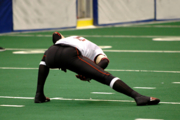Return To Sports: The Internal Battle

One of the more challenging aspects of returning back to a sport is working with the comparison of your ability level before and after your time away. I struggled with this immensely after completing my last collegiate season of Track and Field. I had taken some time away from running and as I returned, I found that I couldn’t help but become frustrated with where my training was at. I was afraid I might never reach the same level of athleticism, and quickly jumped back to a level of training that my body wasn’t ready for. I was riddled with injury, disappointed, and didn’t have the same amount of time to allocate towards the sport due to other responsibilities. Slowly, over time, I came to terms with the situation and have been able to run healthier, happier, more consistently, and with aspirations of being a life-long runner.
It can take a long time and a lot of trial and error to work through some of the emotions associated with the constant performance comparison and reintegration back to sport. However, there are definitely some strategies that can make the journey back a little bit more workable regardless of the sport or performance level you are returning to.
Here are 5 practical tips for reintegrating back to a sport:
1. Compare performance to a recent version of yourself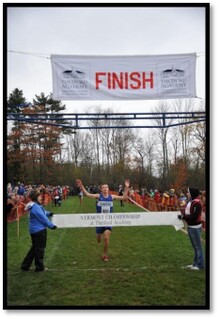
One helpful strategy after taking time away from your sport is to try to compare yourself to where you were only a week or two ago. This allows for greater gratitude for the growth you’ve already made and a more accurate representation of your current abilities. The longer the break away from sport the more important it is to compare to a more a recent version of yourself.
Additionally, in the initial stages of training the heart adapts much quicker than the musculoskeletal system. So, there may be moments where you feel similar to how you did in the past. Your breathing may feel in control, but you might actually be pushing your muscles/ ligaments/ tendons/ bones further than what they can handle. This is where comparing yourself to a more recent version and increasing training gradually can be very beneficial.
2. Make short-term goals and long-term goals
Having the combination of both short-term and long-term goals is another good way to help mitigate the mental traps you can fall into from comparing performance to your old self. Creating SMART goals (Specific, Measurable, Attainable, Realistic, Time-Bound) that compound on themselves allows for you to understand the entirety of your journey instead of seeing your current performance level as something more permanent.
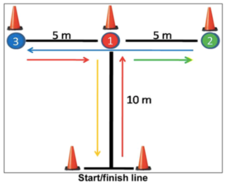
Additionally, in the initial stages of returning back to a sport it may be helpful to create goals that are measurable and still lead to progress in your sport, but are from an area of your sport that you haven’t focused heavily on before. For example, if you are a soccer player and have always wanted to improve your agility, you could create a SMART goal that went something like: I would like to improve my T-test (a cone-based agility test) time by two seconds. This way even though you may not be performing at your all-time best in your sport; you can conceptualize that you’re in process, and have something very specific that you can measure your progress in over time.
As you get closer to playing games or competing again, goals should shift back to sport-specific performance and should be representative of your current fitness/skill levels since returning to sport. For example, if you are a basketball player, you could create a SMART goal that went something like: Improve my shot accuracy by 25% in the next two games. While goal setting, it can be incredibly easy to compare yourself to others. Information is so readily available regarding what the best in the world are doing, or how quickly they recovered from an injury. Understand that everyone’s body is different, we all heal at different rates, so just focus on the things that you can control. Your goals should be a marker of what you think the best version of yourself would be capable of, given the context of your situation.
3. Emphasize consistency over intensity
Another place people can get stuck is the idea that because they have taken some time away from sport, they need to “whip themselves back into shape.” So, they perform the most intense workout they could possibly fathom and are so sore that they can’t walk for the next three days. The more helpful (albeit also more challenging approach) is to prioritize consistency over a long period of time.
Consistency helps make your sport more of a habit; the more it is a habit, the less motivation is needed to perform the activity. The initial stages of training are all about building a base, and the more consistently you can get out there and recover appropriately the bigger that base will be. One analogy is thinking of training as compound interest, if you are able to invest little amounts over a long period of time eventually that interest will compound. On the flip side if you have to keep removing money from the bank the interest will never compound.
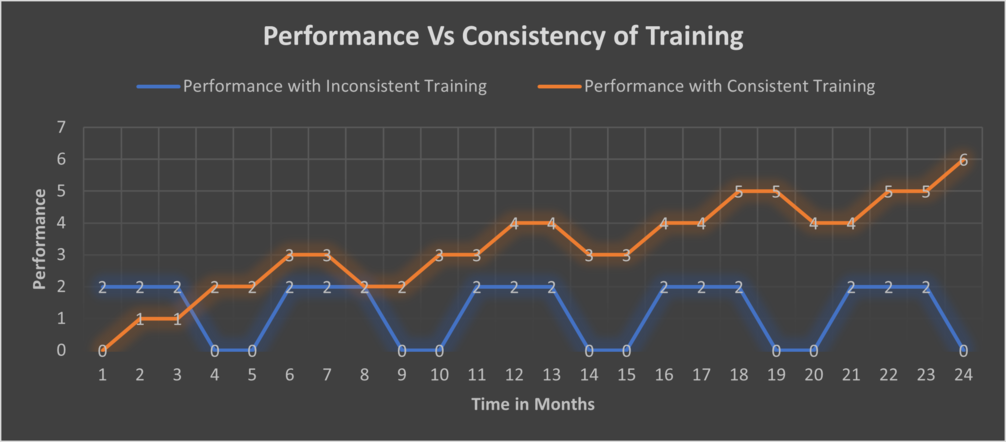
4. Listen to your body
This is probably one of the most common recommendations in the endurance sports realm… but also one of the most commonly ignored. In the initial stages of getting back into your sport, it can be challenging to understand the difference between the normal discomfort of muscle soreness and injury-related pain. On one hand, if you pay attention to every little ache and pain, you may not be able to hit the performance goals you desire. On the other hand, if you ignore your discomfort, you could be setting yourself up for injury and a longer period of time away from your sport. This is definitely where it can be helpful to work with an athletic trainer or physical therapist. They may be able to help you sort through the signals your body is telling you and help brainstorm a plan of action.
Here are some general recommendations to keep in mind when differentiating between injury and soreness:
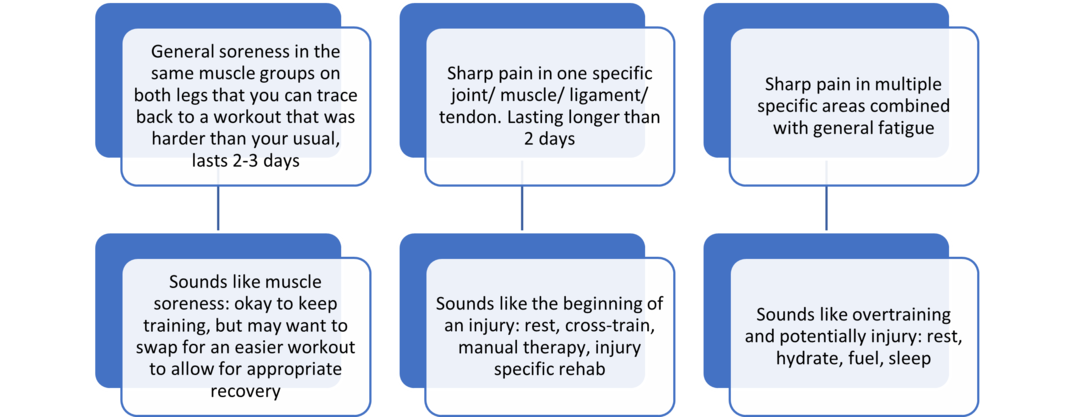
One of the challenging things to realize is that once you’ve identified that you have an injury, there is still a lot that can be done to improve your overall fitness and athletic performance that isn’t the specific thing that is causing the injury. There can be so much fear with hearing the words you need to rest. For a lot of athletes, they think it will be perceived (either to themselves, or to others) as weakness. When in actuality the concept of rest should be viewed simply as refocusing. There is usually some sort of cross-training, strength-training, or treatments that can be done to improve your recovery time and overall performance. And instead of a sign of weakness, resting at the appropriate time should be viewed as a sign of courage, wisdom, and mindfulness. Taking the time to recover when your body doesn’t feel right could help avoid days, weeks, even months of time off down the road if an injury is ignored.
5. It’s okay to have a bad day
Everyone, even the pros, have bad days, bad weeks, bad seasons. One bad day is not a representation of the entirety of your athletic career. Training should be periodized, with planned weeks to rejuvenate and grow stronger. However, sometimes things don’t always go as planned, and that’s okay. Bad days can sometimes be a good opportunity to pause, reflect on any mistakes that could be avoided, and then move on.
We can become blinded by the intensity or the frustration of the day, but if we feel the emotion and then take a step back, we may be able to poke holes in the storyline of what the bad day means for our training. Taking this step back may allow us to move towards a more productive and honest headspace. Eventually the bad day will pass and tomorrow will bring something different. So, get ready to show up mentally, keep up the good work, and have fun!
Happy Training!

